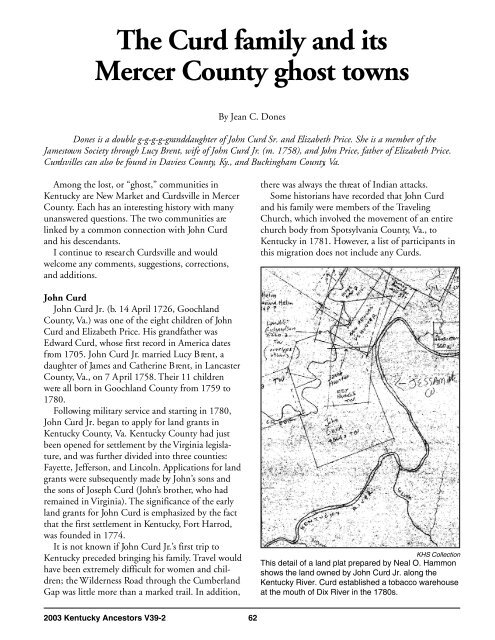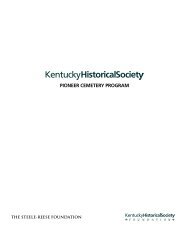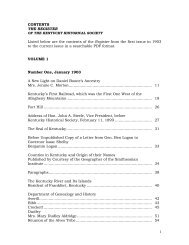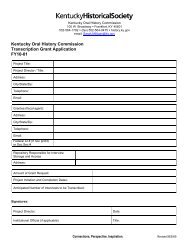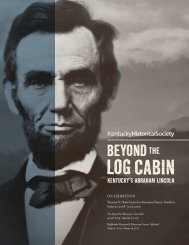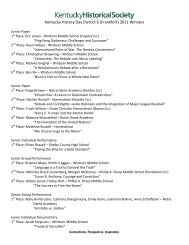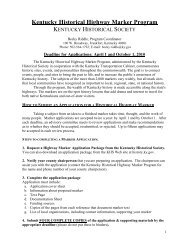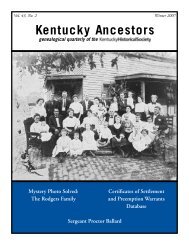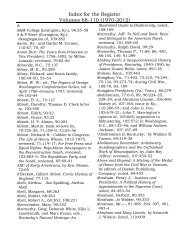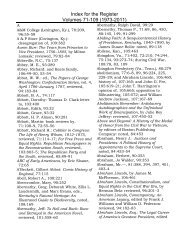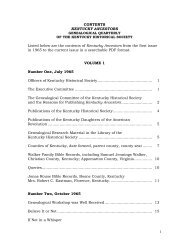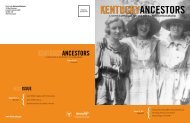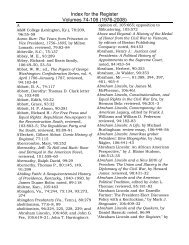Kentucky Ancestors, Volume 39, Number 2 - Kentucky Historical ...
Kentucky Ancestors, Volume 39, Number 2 - Kentucky Historical ...
Kentucky Ancestors, Volume 39, Number 2 - Kentucky Historical ...
You also want an ePaper? Increase the reach of your titles
YUMPU automatically turns print PDFs into web optimized ePapers that Google loves.
The Curd family and its<br />
Mercer County ghost towns<br />
By Jean C. Dones<br />
Dones is a double g-g-g-g-granddaughter of John Curd Sr. and Elizabeth Price. She is a member of the<br />
Jamestown Society through Lucy Brent, wife of John Curd Jr. (m. 1758), and John Price, father of Elizabeth Price.<br />
Curdsvilles can also be found in Daviess County, Ky., and Buckingham County, Va.<br />
Among the lost, or “ghost,” communities in<br />
<strong>Kentucky</strong> are New Market and Curdsville in Mercer<br />
County. Each has an interesting history with many<br />
unanswered questions. The two communities are<br />
linked by a common connection with John Curd<br />
and his descendants.<br />
I continue to research Curdsville and would<br />
welcome any comments, suggestions, corrections,<br />
and additions.<br />
John Curd<br />
John Curd Jr. (b. 14 April 1726, Goochland<br />
County, Va.) was one of the eight children of John<br />
Curd and Elizabeth Price. His grandfather was<br />
Edward Curd, whose first record in America dates<br />
from 1705. John Curd Jr. married Lucy Brent, a<br />
daughter of James and Catherine Brent, in Lancaster<br />
County, Va., on 7 April 1758. Their 11 children<br />
were all born in Goochland County from 1759 to<br />
1780.<br />
Following military service and starting in 1780,<br />
John Curd Jr. began to apply for land grants in<br />
<strong>Kentucky</strong> County, Va. <strong>Kentucky</strong> County had just<br />
been opened for settlement by the Virginia legislature,<br />
and was further divided into three counties:<br />
Fayette, Jefferson, and Lincoln. Applications for land<br />
grants were subsequently made by John’s sons and<br />
the sons of Joseph Curd (John’s brother, who had<br />
remained in Virginia). The significance of the early<br />
land grants for John Curd is emphasized by the fact<br />
that the first settlement in <strong>Kentucky</strong>, Fort Harrod,<br />
was founded in 1774.<br />
It is not known if John Curd Jr.’s first trip to<br />
<strong>Kentucky</strong> preceded bringing his family. Travel would<br />
have been extremely difficult for women and children;<br />
the Wilderness Road through the Cumberland<br />
Gap was little more than a marked trail. In addition,<br />
2003 <strong>Kentucky</strong> <strong>Ancestors</strong> V<strong>39</strong>-2 62<br />
there was always the threat of Indian attacks.<br />
Some historians have recorded that John Curd<br />
and his family were members of the Traveling<br />
Church, which involved the movement of an entire<br />
church body from Spotsylvania County, Va., to<br />
<strong>Kentucky</strong> in 1781. However, a list of participants in<br />
this migration does not include any Curds.<br />
KHS Collection<br />
This detail of a land plat prepared by Neal O. Hammon<br />
shows the land owned by John Curd Jr. along the<br />
<strong>Kentucky</strong> River. Curd established a tobacco warehouse<br />
at the mouth of Dix River in the 1780s.


